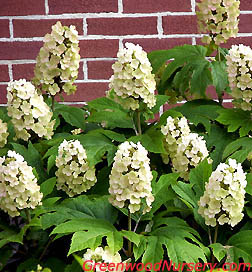Free gardening gloves when you spend $75.00 or more!
Native to shady woodland habitats across the Southeastern United States, oakleaf hydrangeas are now a staple ornamental plant across USDA zones 5-9 in the temperate zone. Boasting large panicles bearing cone-shaped clusters of off-white blossoms, these hydrangeas are unlike most of their relatives, which typically flower in a dome-like shape.
Numerous cultivars are available, so beyond shopping for the the distinctive leaf shape among the hydrangeas, look for the binomial name for the shrub: Hydrangea quercifolia. Both parts of this name say quite a lot about the plant. Hydrangea comes from the Greek “hydor," meaning water, and "angos,” meaning cup: this tells you that the plant is a heavy consumer of water, and won’t tolerate a dry spot without significant irrigation. Quercifolia comes from the Latin “quercus,” meaning oak, and “folium,” meaning leaf: this aspect of the name has been translated to the English common name of “oakleaf,” and speaks to the distinctive lobed shape of the leaves.
Growing Oakleaf Hydrangeas.
As with many plants that live on the organic matter rich floor of the forest, oakleaf hydrangeas prefer a slightly acidic soil: with an ideal pH range of 5.0–6.5. Seemingly paradoxically, they also grow well in soils with more lime or chalk than other acidic soil lovers like rhododendrons or blueberries. Thus, a soil blend with leaf mold, compost, and a helping of dolomitic lime can be the right mix for successfully planting oakleaf hydrangeas.
As an understory plant, oakleaf hydrangeas will thrive in partial or full shade, delivering a large crop of flowers in a spot with cool morning sun and afternoon shade against the heat. In natural assemblages, they grow well with magnolias, oaks, beech, and hickories, although they can successfully be planted under an array of tree species, provided attention is paid to soil pH.
Though cultivars vary in size, many will grow over 8 feet in height, although they can be kept compact with pruning, and propagated via cuttings or layering.
Any way you grow them, however, oakleaf hydrangeas are beautiful and versatile shade-loving native plants for US gardens.
- cheryl's blog
- Log in or register to post comments








